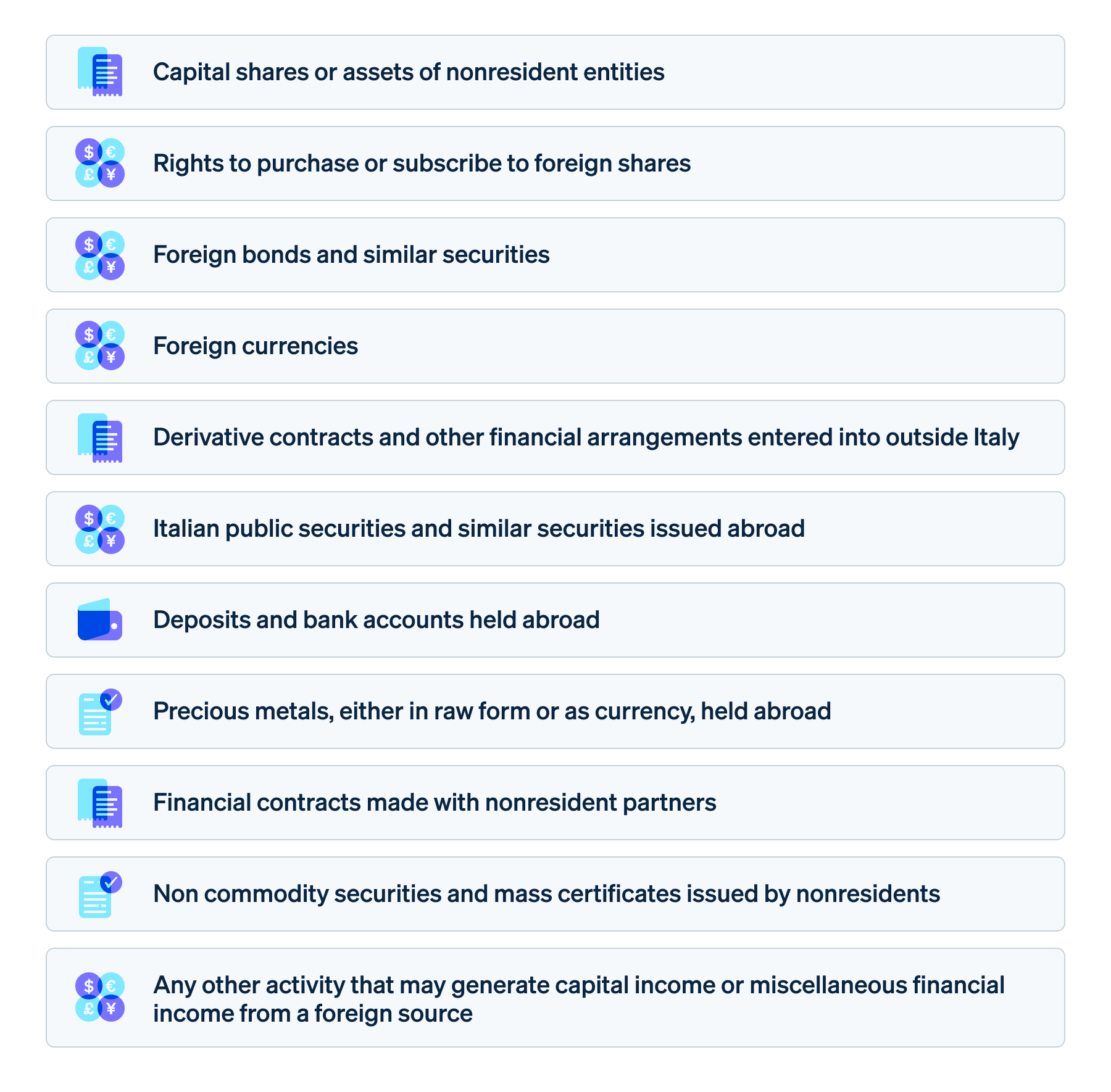イタリアの税務当局は、海外に金融資産を持つ特定の納税者に、それらの保有資産の価値に対する富裕税を課しています。これは「海外金融資産の価値に対する税金」または IVAFE (イタリア語で「Imposta sul Valore delle Attività Finanziarie all'Estero」) と呼ばれます。このような変更は、イタリアの個人所得税 (IRPEF) や法人所得税(IRES) など、特定の期間に発生した利益に基づく変更とは異なり、資産の価値 (納税者の純資産) に基づきます。この記事では、IVAFE の概要、納税対象者、適用税率、申告書の提出方法について説明します。
この記事の内容
- IVAFE とは
- 申告すべき外国金融資産
- IVAFE から除外される資産
- IVAFE の計算方法
- 個人の納税申告における IVAFE
- IVAFE の支払い方法
IVAFE とは
IVAFE は、政令第 201/11 号により導入されました。当初は個人のみに課税されていましたが、2020 年 1 月 1 日以降は、1990 年政令第 167 号の第 4 条に基づき投資や資産を申告すべきイタリアの非営利事業体および単純企業 (税務監視として知られるプロセス) も、IVAFE の対象となっています。したがって、これらの納税者が保有する海外金融資産は、現在、課税対象となっています。
このケースのうち、どのようなものが「金融資産」とみなされるのでしょう?これには、海外の資金源から資本または雑収入を生み出すすべての金融活動および商品が含まれます。
IVAFE 税率
当座預金と普通預金を除くすべての資産について、税務当局は税率 0.2% の IVAFE を課します。経済財務省の政令 04/05/1999 (改正) で特定される優遇税制の国で保有されている金融商品の場合、2024 年の IVAFE の年率は 0.4% です (2024 年予算法-第 1 条第 91 項 b)。
個人が海外で保有する当座預金および貯蓄預金の場合、IVAFE は定額 34.20 ユーロに設定されています。個人以外の事業体の場合、この税額は 100 ユーロに設定されています。法人は、口座明細書または普通預金の年間平均残高が 5,000 ユーロを超える場合にのみ税金を支払う必要があります。
申告すべき外国金融資産
この法律では、企業は税務監視の対象となる資産を所得 PF フォームのパート RW で報告することが義務付けられています。この報告は、IVAFE の支払い義務につながる可能性があります。企業が所得 PF フォームのパート RW で申告しなければならない対外金融資産は、以下のとおりです。
- 非居住企業 (外国企業、財団信託などの法人など) の資本金または資産
- 海外の保険業者との融資、繰越、買戻し契約、有価証券貸付、生命保険契約など、非居住パートナーとの間で締結された金融契約
- 外国株式または類似の金融商品を購入または引き受ける権利
- 外国債券その他これに類する有価証券
- イタリアの公債および海外で発行された類似の株式
- 集団投資スキーム (OICR) を含む、非居住者が発行する非商品証券および大量証券
- 外貨
- 給与、年金、報酬控除などの資金源に関係なく、海外に保有されている預金および銀行口座
- イタリア国外で締結されたデリバティブ契約およびその他の金融契約
- 海外で保有されている貴金属 (未加工または通貨として)
- 海外の資金源から資本または雑貨収入を生み出す可能性があるその他の活動
また企業は、海外で保有するイタリアの金融資産 (イタリアで発行された国債、居住企業の株式、その他の金融商品など) についても、雑所得が発生する可能性があるため、パート RW で報告する必要があります。
納税申告が必要な外国金融資産のリスト:

IVAFE から除外される資産
税務当局は、一部の金融資産を IVAFE の課税対象から除外しています。以下のとおりです:
- 外国法に準拠する企業や機関によって組織または管理される、補足的な年金枠組み。
- 海外で保有されているが、イタリアに拠点を置く金融仲介機関によって管理されている資産。
- イタリアで納税者が物理的に保有している外国資産。
IVAFE の計算方法
IVAFE の課税標準を決定する標準的な方法は、暦年の最終日時点での金融資産の市場価値に基づいて計算することです。イタリアの居住者が当該年の 12 月 31 日にこれらの投資を保有しなくなった場合、保有期間の終了時に市場価格を決定する必要があります。
規制市場に上場されている金融資産については、12 月 31 日時点または保有期間終了時の時価を使用する必要があります。規制された市場で取引されていない投資の場合、または上場資産が上場廃止になっている場合は、参照用に公式に再表示されているかどうかにかかわらず、額面金額または不明な場合は償還額を使用します。額面価額と償還価額のいずれも不明である場合は、有価証券の買取価格で課税標準を決めます。
IVAFE 前払金を計算するには、前年度に決定された税額の 100% を使用します。たとえば、残高税が 150 ユーロの場合、前払いも 150 ユーロである必要があります。この場合、金額が 103 ユーロのしきい値を超えているため、前払いを 2 回に分けて支払う必要があります。
二重課税と税額控除
納税者が金融商品、当座預金、または普通預金口座を保有している国で相続税を支払っている場合、IVAFE を計算する際に、海外で支払った相続税の額と同額の税額控除 (政令第 201/11 号第 19 条第 21 項) を差し引くことができます。いずれにせよ、このクレジットはイタリアで支払うべき金額が上限です。
ただし、IVAFE のこの控除は、金融資産を保管している国と二重課税協定が締結されており、その協定に富裕税の規定がある場合には適用されません。この場合、名義人の居住国が適用税率を決定します。
個人の納税申告における IVAFE
海外に金融資産を保有している個人は、納税申告時に報告する必要があります。これは、所得 PF フォームのパート RW 、または 2024 年以降は、パート RW と同じ税務監視専用のフォーム 730/2024 のパート W で行うことができます。
IVAFE は富裕税ですが、その計算と決済は、個人所得税 (IRPEF) に適用されるのと同じ規制の条項に従います。納税者は、口座と残高の両方で支払いを行う必要があります。また、PF 所得フォームにおいて IVAFE のパート RW6、列 1 に示されている金額が 52 ユーロのしきい値を超える場合は、前払いが必要です。金額がこのしきい値を下回っている場合は、残高のみを決済する必要があります。
IVAFE の前払い金が 103 ユーロを超える場合 (DPR第 435/2001 号第 17 条第 3 項)、2 回に分けて支払う必要があります。
- 最初の分割払いでは 40% にあたる額を、前年の納税申告書の提出期限である 6 月 30 日までに支払う必要があります。
- 2 回目の分割払いで、1 回目の分割払いを差し引いた後の残高にあたる額を、11 月 30 日までに支払います。
分割払いをしない場合は、11 月 30 日までに全額を一括で決済する必要があります。
絶えず変化する規制に対応することは、企業とって困難な場合があります。Stripe Tax などのツールを利用すると、納税申告書の提出に役立つ詳細なレポートが生成されるため、効率的に法令を遵守できます。
IVAFE の支払い方法
VAT 登録済みの納税者は、電子的に提出する義務があるフォーム F24 を使用して、IVAFE を支払う必要があります。これは、Agenzia delle Entrate (イタリア歳入庁) が提供する F24 web または F24 online ソフトウェアを使用して、Fisconline チャネルまたは Entratel チャネルを介して直接行うことができます。または、信用機関のホームバンキングサービスか認可された仲介業者を通じて行うことができます。
VAT の対象ではない保有者は、クレジットで相殺をしない場合に限り、銀行、Poste Italiane の支店、および回収業者で、紙の F24 フォームを使用して支払うこともできます。ただし報酬に税額控除を使用する場合、紙の F24 フォームを提出することは回収業者でのみ可能です。
IVAFE の支払いには、次の税コードを使用する必要があります。
- 4043:イタリア領土に居住する個人が海外で保有する金融資産の価値に対する税金 — 第19 条、第18 項、DL. n.201/2011 批准、L.n.214/2011 およびその後の変更により修正 — 残高
- 4047:イタリア領土に居住する個人が海外で保有する金融資産の価値に対する税金 — 第19 条、第18 項、DL. n.201/2011 批准、L.n.214/2011 およびその後の変更により修正 — 入金分割払い 1 回目
- 4048:イタリア領土に居住する個人が海外で保有する金融資産の価値に対する税金 — 第19 条、第18 項、DL. n.201/2011 批准、L.n.214/2011 およびその後の変更により修正 — 入金分割払い 2 回目または一括入金
この記事の内容は、一般的な情報および教育のみを目的としており、法律上または税務上のアドバイスとして解釈されるべきではありません。Stripe は、記事内の情報の正確性、完全性、妥当性、または最新性を保証または請け合うものではありません。特定の状況については、管轄区域で活動する資格のある有能な弁護士または会計士に助言を求める必要があります。